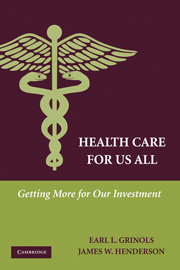Book contents
- Frontmatter
- Contents
- List of Tables
- List of Figures
- Preface
- Acknowledgments
- Executive Summary of the Targeted Intervention Plan
- PART I GOALS AND WORKING PRINCIPLES
- 1 Introduction
- 2 Goals
- 3 Principles
- PART II BACKGROUND ECONOMICS AND ETHICS
- PART III APPLICATION
- PART IV PROTECTIVE MEASURES
- A Top Ten Goals for the American Health Care System
- B Badly Done Insurance Programs Can be Worse Than No Insurance
- C Incentive Symmetry and Intervention Principle
- D Plan Workability
- E Market Power Response to Insurance
- Glossary and Definitions
- References
- Index
1 - Introduction
Published online by Cambridge University Press: 05 June 2012
- Frontmatter
- Contents
- List of Tables
- List of Figures
- Preface
- Acknowledgments
- Executive Summary of the Targeted Intervention Plan
- PART I GOALS AND WORKING PRINCIPLES
- 1 Introduction
- 2 Goals
- 3 Principles
- PART II BACKGROUND ECONOMICS AND ETHICS
- PART III APPLICATION
- PART IV PROTECTIVE MEASURES
- A Top Ten Goals for the American Health Care System
- B Badly Done Insurance Programs Can be Worse Than No Insurance
- C Incentive Symmetry and Intervention Principle
- D Plan Workability
- E Market Power Response to Insurance
- Glossary and Definitions
- References
- Index
Summary
I do not believe in a fate that falls on men however they act; but I do believe in a fate that falls on them unless they act.
G. K. Chesterton, English author (1874–1936)Summary: Many despair of solving the health care crisis in America, currently defined by the presence of large numbers of uninsured, large numbers of indigent and other limited-pay and no-pay users, rising costs, questionable quality, and budgetary challenges exacerbated by an aging baby boom generation. The problems are real, but the despair is unfounded.
Working from the requirements that Americans say they want their health care system to satisfy and applying economic principles to meet these stated objectives identify a unique framework within which options for implementation can be selected. The key to a self-sustaining program is respecting the relevant principles and intervening at the minimal set of system points required to accomplish the objectives.
There is growing recognition that the time is at hand for serious action on American health care policy. Even though 8 out of 10 Americans are happy with their own medical care experiences, approximately the same percentage are concerned that the U.S. health care system is not functioning as it should for others and requires serious attention. At the time of writing, the Census Bureau estimates that 15.8 percent of Americans are without health insurance at any point. Because almost 60 percent of all uninsured were employed in full-time or part-time jobs, it is a fair approximation to say that over 75 percent of the uninsured have some labor force connection – through their own employment or that of a family member.
- Type
- Chapter
- Information
- Health Care for Us AllGetting More for Our Investment, pp. 3 - 16Publisher: Cambridge University PressPrint publication year: 2009



